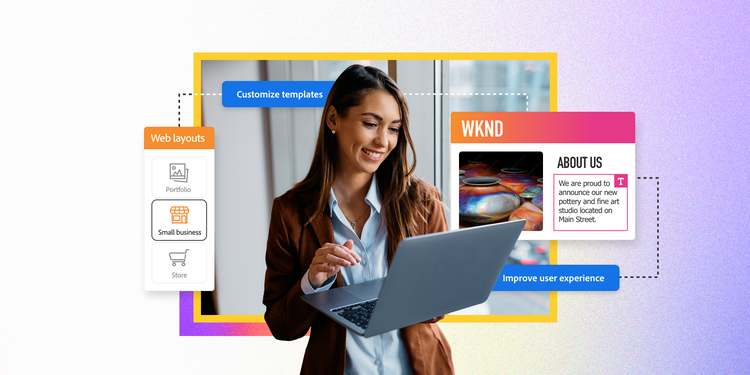How Website Design Impacts Brand Perception and Trustworthiness
Wiki Article
The Ultimate Overview to Modern Internet Site Style Trends
In the ever-evolving digital landscape, modern-day internet site layout patterns play an important role in forming individual experience and engagement. From the rise of minimal design principles that focus on simpleness to the impact of vibrant typography in specifying brand name identification, each component contributes to a cohesive on the internet existence. The focus on responsive and mobile-first strategies, along with ingenious microinteractions, further enhances usability. Additionally, the expanding emphasis on sustainable web layout techniques mirrors a dedication to ecological responsibility. These trends collectively increase important questions about the future of reliable internet design and what it means for organizations and customers alike.Minimalist Layout Principles
Minimal design principles emphasize the idea that much less is a lot more, promoting for simpleness and capability in aesthetic communication. This strategy strips away unneeded aspects, focusing instead on vital components that convey the designated message efficiently. By prioritizing clarity, minimalist style boosts individual experience, enabling visitors to browse sites easily.
Core tenets of minimalist design consist of making use of adequate white space, which creates a feeling of equilibrium and organization. This negative space not just directs the customer's focus to crucial elements but also cultivates a soothing visual atmosphere. Additionally, a restricted shade combination is frequently employed, using monochromatic schemes or soft hues to preserve visual communication and prevent overwhelming the customer.
Typography plays an essential role in minimal style, where understandable typefaces are chosen for their simpleness and efficiency in interacting web content. Eventually, minimalist design principles grow a concentrated environment that encourages customers to engage with the material, improving the overall efficiency of contemporary internet site style.
Bold Typography Selections
Accepting vibrant typography selections has become a specifying characteristic of modern web site design, as it properly captures focus and shares solid messaging. Developers are increasingly making use of typography not just as a useful component but as a vital visual component that improves the general visual and customer experience.
Furthermore, the association of vibrant typography with minimal design principles permits striking contrasts, boosting readability while maintaining visual allure. The usage of whitespace around bold message further highlights its relevance, guaranteeing that the message resonates with the audience.
As digital landscapes become a lot more affordable, leveraging bold typography allows brand names to differentiate themselves and leave an enduring perception. The careful choice of fonts and their application can stimulate feelings, establish tone, and drive activity, making bold typography a vital tool in modern site layout. Inevitably, it is a powerful way to improve narration and make sure that crucial messages are not just seen but also really felt.
Receptive and Mobile-first Design
Receptive and mobile-first design has become a crucial concept in modern web site development, reflecting the boosting dependence on smart phones for accessing online content. As user behavior shifts towards mobile surfing, designers must focus on creating experiences that adapt perfectly across various display dimensions and resolutions.A responsive style makes sure that a web site instantly changes its format, photos, and capability based upon the device being made use of. This approach enhances individual experience by providing consistent navigation and readability, regardless of whether the visitor gets on a desktop computer, smart device, or tablet computer computer. Mobile-first special info style advocates for developing web sites at first for smaller sized screens, ultimately scaling up to bigger screens. This approach motivates a more effective and streamlined layout procedure, focusing on important web content and performance initially.
Implementing mobile-first and responsive concepts not only caters to user choices yet likewise straightens with seo (SEARCH ENGINE OPTIMIZATION) practices. Significant internet search engine, like Google, focus on mobile-friendly sites in their rankings, making it crucial for companies to take on these style approaches. learn this here now In a competitive digital landscape, accepting responsive and mobile-first layout is not simply an alternative; it is essential for making sure accessibility and engagement with a varied target market.
Engaging Microinteractions
Microinteractions play a pivotal duty in enhancing user interaction and overall site experience, specifically in the context of mobile-first and responsive design. These subtle style elements supply immediate comments to users, making communications more intuitive and pleasurable. Examples include switch animations, notice alerts, and loading indications, which not only guide customers but likewise create a feeling of link with the interface.Integrating engaging microinteractions can substantially boost usability by reducing cognitive load. When customers get visual or auditory feedback upon performing actions, such as find out clicking a switch or submitting a form, they really feel more confident in their choices. This fosters a smoother navigating experience, eventually increasing customer retention.

As internet site design patterns continue to develop, the value of microinteractions can not be overstated. They serve as the refined yet effective touchpoints that change ordinary communications into phenomenal experiences, therefore boosting the overall efficiency of modern-day internet design.
Sustainable Internet Style Practices
Lasting internet layout practices are coming to be increasingly necessary as the digital landscape grows and ecological issues rise. Developers and developers are acknowledging their responsibility to produce websites that not just serve user requirements but also minimize ecological effect. This method encompasses several vital methods.Firstly, maximizing power usage is extremely important. Websites must be designed to fill swiftly and successfully, which reduces server power usage and boosts user experience. Strategies such as image compression, reducing HTTP requests, and making use of modern coding practices add considerably to this objective.
Secondly, choosing eco-friendly organizing companies is crucial - website design. Many holding firms are now powered by sustainable power sources, enabling websites to operate in an extra lasting manner. This selection reflects a commitment to reducing carbon footprints
Additionally, taking on a minimalist design can improve sustainability. Less components on a web page cause much less information transfer, which not only quickens loading times but also conserves sources.
Lastly, promoting electronic accessibility guarantees that web sites get to a bigger audience without unneeded bloat, aligning user experience with environmental responsibility. By incorporating these lasting techniques, internet designers can contribute positively to both user engagement and the world's wellness.
Final Thought
In recap, modern internet site style patterns emphasize the assimilation of minimalist principles, bold typography, and receptive design to improve user experience. Taking on these patterns is necessary for developing impactful digital experiences that reverberate with users in a progressively competitive on-line landscape.In the ever-evolving electronic landscape, modern-day site design patterns play an essential role in forming individual experience and interaction. By focusing on clarity, minimalist layout improves customer experience, allowing site visitors to browse web sites easily.
Eventually, minimal style concepts grow a focused environment that encourages users to engage with the web content, improving the total performance of modern-day internet site design.Microinteractions play a pivotal role in enhancing individual interaction and total website experience, especially in the context of mobile-first and responsive style.In summary, modern site style trends stress the integration of minimalist concepts, bold typography, and responsive design to improve customer experience.
Report this wiki page